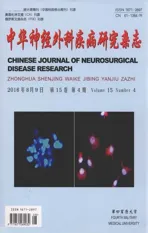骨髓间充质干细胞对癫痫模型认知及海马区GABAA受体表达的影响
2016-11-25黑悦刘卫平魏礼洲伊西才陈晓燕
黑悦 刘卫平 魏礼洲 伊西才 陈晓燕
(第四军医大学西京医院神经外科,陕西 西安 710032)
·功能神经外科疾病研究·
骨髓间充质干细胞对癫痫模型认知及海马区GABAA受体表达的影响
黑悦 刘卫平*魏礼洲 伊西才 陈晓燕
(第四军医大学西京医院神经外科,陕西 西安 710032)
目的探究骨髓间充质干细胞(BMSCs)移植对大鼠癫痫模型认知功能及海马CA1区域γ氨基丁酸A受体(GABAARs)的表达的影响。方法成年雄性SD大鼠30只随机分为正常组(n=10),模型组(n=10)和实验组(n=10)。采用匹鲁卡品诱导癫痫模型,2 h后移植进行BMSCs移植,28 d后水迷宫检测认知变化,免疫组化和实时荧光定量PCR(RT-PCR)检测大鼠海马CA1区GABAARs的表达变化。结果RT-PCR和免疫组化结果显示,模型组相比正常组GABAAR α1表达水平(mRNA以及免疫组化染色强度)下调(Plt;0.05)而GABAAR α4上调(Plt;0.05),移植组GABAARs相关改变比模型组轻微(Plt;0.05),且认知功能改善明显(Plt;0.05)。结论BMSCs移植可调节大鼠癫痫模型中海马区域GABAARs表达水平并减轻癫痫相关认知障碍。
骨髓间充质干细胞; 癫痫; 认知障碍; 细胞移植; GABAA型受体
癫痫是一种常见病,一方面病理机制十分复杂,基础与临床研究鲜有进展;另一方面相关治疗药物敏感性差,长期服用副作用大[1]。骨髓间充质干细胞(bone marrow mesenchymal stem cells,BMSCs)移植具有安全低毒、效果持久等特点,近年来演变为癫痫治疗的新兴手段[2,3]。目前研究更多专注于BMSCs移植后的生物学特性,比如迁移,分化和整合等,但是对于移植后海马区域整体的调控缺乏系统研究[4~7]。γ氨基丁酸(Gamma aminobutyric acid,GABA)能神经传导对癫痫疾病中神经元兴奋性和认知功能的调节有重要作用[8]。而GABAA型受体(GABAA receptors,GABAARs)介导了GABA能抑制性突触信号,在癫痫发病后慢性期α1亚型(主要定位于突触内,参与快速相位抑制)表达下调,而α4亚型(主要定位于突触外,参与连续的紧张性抑制)上调[7,9]。此种改变与癫痫相关认知障碍密切相关[10]。癫痫模型中移植后的BMSCs能够迁移到海马区域,有效降低癫痫发作频率并缓解认知障碍,然而对海马区域GABAARs的整体调节仍未明晰[5,6]。
本实验拟通过建立匹鲁卡品诱导的大鼠癫痫模型,应用实时荧光定量PCR(real-time PCR,RT-PCR),免疫组化和水迷宫技术观察慢性期大鼠CA1区域的GABAARs表达变化以及认知功能的改善情况,以此阐明BMSCs移植在癫痫模型中的新的治疗机制。
材料与方法
一、实验动物和分组
全部健康成年Sprague Dawley(SD)大鼠(雄性,230~250 g)30只,由第四军医大学实验动物中心提供。实验动物随机分为正常组(n=10),模型组(n=10)和移植组(n=10)。遇到有造模失败或死亡,则将另外补充。
二、大鼠癫痫模型的制作
按照127 mg/kg体重腹腔注射氯化锂,18~24 h后腹腔注射匹鲁卡品(pilocarpine)350 mg/kg,注入前30 min腹腔注入东莨宕碱1 mg/kg,以拮抗其外周胆碱能反应,观察癫痫发作情况。癫痫发作等级按Racine标准判定[11]。当大鼠出现肢体阵挛或全身强直阵挛频繁或持续1 h以上时,按300 mg/kg体重腹腔注射10%水合氯醛终止癫痫发作。在此次癫痫持续状态之后对其进行24 h视频监测,将Racine分级Ⅲ级以上发作定义为有效发作。
三、骨髓间充质干细胞培养和移植
取2周龄SD雄性大鼠,腹腔麻醉(10%水合氯醛,3 mg/kg)后浸泡在75%酒精中15 min,取出双侧股骨骨髓,用5 ml生理盐水反复冲洗后收集5 ml骨髓液,2 500 rpm/min离心20 min,生理盐水洗2遍后加入基础培养基(alpha-minimum essential medium,α-MEM),10%胎牛血清(fetal bovine serum,Hyclone,USA)接种于25 ml塑料培养瓶,放人37℃,5% CO2的孵箱中静置培养48 h后换液。细胞铺满培养瓶平底80%左右时用胰酶消化传代。取第三代骨髓间充质干细胞待用。模型建立2 h后,腹腔麻醉(10%水合氯醛,3 ml/kg),经尾静脉注射1 ml浓度为1×107个第三代骨髓间充质干细胞,模型组和正常组经尾静脉注射1 ml生理盐水。
四、水迷宫行为学分析
水迷宫测试一共分为两步。首先为定位航行测试(place navigation),各组大鼠(n=5)进行连续4 d的平台寻找训练。每天分别从4个象限固定的位置入水,时间限定为60 s,各象限之间间隔15 s,记录大鼠不同入水点找到平台所需的时间,即游泳潜伏期(4次游泳潜伏期平均值)。若其没有找到平台,则记为60 s,同时仍使大鼠站在平台上15 s。而后是空间探索测试(spatial probe),在第5天将平台撤去后记录大鼠从4个象限不同入水点到平台所在象限停留时间以及穿越平台所在区域的次数,时间设定为60 s,其余相同。
五、大鼠脑组织标本制备及GABAARs免疫组化染色
模型建立后第28天分别取各组5只SD大鼠,以200 ml生理盐水灌注后用4%多聚甲醛灌注固定。常规石蜡包埋,常规脱蜡至水后柠檬酸抗原修复分别加入GABAAR α1(1∶500,Abcam,美国)和 GABAAR α4(1∶500,Sigma,美国)抗体,在4℃冰箱中赋予过夜,洗脱。滴加辣根过氧化物酶标记的山羊抗兔IgG,室温孵育2 h。二氨基联苯胺(diaminobenzidine,DAB)染色,自来水冲洗,苏木素复染,常规脱水透明并封片,光镜下分析计数。
六、大鼠海马CA1区域GABAARs的RT-PCR检测
麻醉状态下经左心室持续灌注200 ml 0.01 mol/L PBS后,在冰上断头轻柔分离大鼠海马CA1组织(而后可存放于-80℃冰箱中),使用TRIzol试剂盒 (Invitrogen,美国)提取总RNA。RT-PCR反应混合物包含SYBR®Premix ExTaqTMII (TaKaRa,大连)10 μl,正反引物各1 μl,cDNA 2 μl及6 μl无核酸酶的水。各引物序列分别为(GABAAR alpha1) 正:5'-CTC TGA CTA TCT TTG GGC CTG GAC-3' 和反:5'-TCC TCG TGA AGA CAG TGG TGT TG-3'; (GABAAR alpha4) 正5'-GCC CGG AAA ATT TTA CCC GTA TC-3' 和反:5'-GAG CTG TCA TGT TAT GGG AGA C-3'; (GAPDH) 正:5'-GCA TTG CTC TCA ATG ACA ACT T-3' 和反:5'-GGC CTC TCT CTT GCT CTC AGT-3'.。
七、统计分析
所有定量数据均以均数±标准差(Mean±SD)表示,应用SPSS 19.0统计软件对数据进行统计分析。双因素方差分析用于水迷宫各参数分析,单因素方差分析用于检测GABAARs的表达水平。以Plt;0.05为有统计学意义。

图1 水迷宫认知测试
Fig 1 Learning and memory tests by Morris Water Maze
A:The escape latency; B:The percentage of time spending in the target quadrant; C:The number of platform crossings.
aP=0.0044,lt;0.01 for training 3 d;bP=0.0006,lt;0.001 for training 4 d and single probe tasks;cP=0.0288,lt;0.05 in the percentage of time spending in the target quadrant;dP=0.0411,lt;0.05 in the number of platform crossings compared to positive control group.
The data are Mean ± SD. N=5 per group.

图2 GABAARs的免疫组化染色及RT-PCR结果
Fig 2 Immunohistochemical staining and RT-PCR results of GABAARs
A~F:Representative images of GABAAR α1 and α4-positive cells (positive control group and experimental group) in the hippocampal CA1 subfield (A~D) and quantification analysis among the three groups (E,F); G~H:The GABAAR α1 and α4 mRNA levels. BMSCs transplantation partly reversed the changes.
aP=0.0457,lt;0.05 of GABAAR α1,bP=0.0076,lt;0.01 of GABAAR α4,vspositivecontrol group;cP=0.0473,lt;0.05 of GABAAR α1,dP=0.0476,lt;0.05 of GABAAR α4vspositive control group.
The data are Mean±SD. Scale bar=20 μm.
结 果
一、水迷宫
如图1所示,模型组相比正常组的游泳潜伏期有明显差距(Plt;0.05)。实验组(BMSCs移植)在训练的3 d游泳潜伏期相比模型组显著下降(aP=0.0044,lt;0.01),而在4 d则更为明显(bP=0.0006,lt;0.001)。而在随后的空间探索测试中,实验组相比模型组仍旧显现出更强的探索能力(cP=0.0288,lt;0.05目标象限停留时间;dP=0.0411,lt;0.05穿越平台所在区域的次数)。
二、免疫组化
如图2A-F所示,模型组GABAARα1阳性细胞相比正常组显著增多(Plt;0.05),而GABAARα4呈现相反的改变(Plt;0.05)。相比模型组,BSMCs移植(实验组)不同程度的调节了这种双向的GABAARs受体的变化(aP=0.0457,lt;0.05 GABAARα1;bP=0.0076,lt;0.01 GABAARα4)。
三、RT-PCR
与免疫组化结果相对应,大鼠癫痫模型的海马CA1区GABAARs mRNA水平也呈现相应的双向变化(Plt;0.05,图2 G~H)。与此同时,实验组相比模型组,GABAARs mRNA表达水平显著改变(cP=0.0473,lt;0.05 GABAARα1,dP=0.0476,lt;0.05 GABAARα4)。
讨 论
骨髓间充质干细胞移植目前已经广泛应用于治疗脑损伤,亨廷顿病,肌萎缩侧索硬化和癫痫等疾病[3]。虽然其分化能力有限,但旁分泌和迁移能力较强[12],可以靶向迁移到海马区域后可以旁分泌众多细胞因子,比如GABA,血管内皮生长因子(vascular endothelial growth factor,VEGF),神经生长因子(nerve growth factor,NGF)等来改善微环境[5,6,13]。BMSCs移植后对在体GABA能系统的调控作用已有报道,然而其是否对癫痫慢性期大鼠海马区GABAARs的表达产生影响仍未明晰。本研究结果显示BMSCs移植后28 d,移植组在MWM各项指标以及GABAARs的表达变化中都不同程度的优于模型组,提示BMSCs可以通过改变抑制性突触中的关键分子靶点来调节GABA能神经传导,从而起到认知改善的作用。
认知障碍在啮齿动物模型和人颞叶癫痫 (temporal lobe epilepsy,TLE)中均有发生[1]。关于癫痫相关认知认知障碍的潜在机制有许多假说,如标记GABA能细胞选择性损伤以及海马GABA神经传导水平下降等[14]。越来越多的证据表明作为海马区域对学习和记忆至关重要,调控海马区域GABAARs的表达对认知障碍的改善有积极作用[15]。我们认为移植后BMSCs对GABAARs的调节在认知功能改善中扮演了重要角色。
本实验通过建立匹鲁卡品诱导的大鼠癫痫模型,观察了BMSCs移植后对GABAARs表达以及癫痫相关认知障碍的改善作用。证明BMSCs移植可通过调节海马CA1区GABAARs水平来达到认知功能改善的疗效,为癫痫模型中干细胞移植提供了新的理论基础。然而,BMSCs如何调控GABAARs,其中的信号通路和突触结构中的分子靶点仍有待进一步研究。
1Varvel NH,Jiang J,Dingledine R. Candidate drug targets for prevention or modification of epilepsy [J]. Annu Rev Pharmacol Toxicol,2015,55:229-247.
2Agadi S,Shetty AK. Concise review:prospects of bone marrow mononuclear cells and mesenchymal stem cells for treating status epilepticus and chronic epilepsy [J]. Stem Cells,2015,33(7):2093-2103.
3Roper SN,Steindler DA. Stem cells as a potential therapy for epilepsy [J]. Exp Neurol,2013,244:59-66.
4Venturin GT,Greggio S,Marinowic DR,et al. Bone marrow mononuclear cells reduce seizure frequency and improve cognitive outcome in chronic epileptic rats [J]. Life Sci,2011,89(7-8):229-234.
5Long Q,Qiu B,Liu W,et al. Functional recovery and neuronal regeneration of a rat model of epilepsy by transplantation of Hes1-down regulated bone marrow stromal cells [J]. Neuroscience,2012,212:214-224.
6Long Q,Qiu B,Wang K,et al. Genetically engineered bone marrow mesenchymal stem cells improve functional outcome in a rat model of epilepsy [J]. Brain Research,2013,1532:1-13.
7Braat S,Kooy RF. The GABAA Receptor as a Therapeutic Target for Neurodevelopmental Disorders [J]. Neuron,2015,86(5):1119-1130.
8Hunt RF,Girskis KM,Rubenstein JL,et al. GABA progenitors grafted into the adult epileptic brain control seizures and abnormal behavior [J]. Nat Neurosci,2013,16(6):692-697.
9Grabenstatter HL,Russek SJ,Brooks-Kayal AR. Molecular pathways controlling inhibitory receptor expression [J]. Epilepsia,2012,53(Suppl 9):71-78.
10Brooks-Kayal AR,Shumate MD,Jin H,et al. Selective changes in single cell GABA(A) receptor subunit expression and function in temporal lobe epilepsy [J]. Nat Med,1998,4(10):1166-1172.
11Racine RJ. Modification of seizure activity by electrical stimulation. I. After-discharge threshold [J]. Electroencephalogr Clin Neurophysiol,1972,32(3):269-279.
12Abdanipour A,Tiraihi T,Mirnajafi-Zadeh J. Improvement of the pilocarpine epilepsy model in rat using bone marrow stromal cell therapy [J]. Neurol Res,2011,33(6):625-632.
13龙乾发,刘卫平,玉石,等. 体外诱导大鼠骨髓间充质干细胞向GABA能神经元分化 [J]. 中华神经外科疾病研究杂志,2009,8(6):505-508.
14Wei D,Yang F,Wang Y,et al. Degeneration and regeneration of GABAergic interneurons in the dentate gyrus of adult mice in experimental models of epilepsy [J]. CNS Neurosci Ther,2015,21(1):52-60.
15Cizkova D,Kakinohana O,Kucharova K,et al. Functional recovery in rats with ischemic paraplegia after spinal grafting of human spinal stem cells [J]. Neuroscience,2007,147(2):546-560.
EffectofbonemarrowmesenchymalstemcellsoncognitionandtheexpressionofGABAARsinthehippocampusinaratmodelofepilepsy
HEIYue,LIUWeiping,WEILizhou,YIXicai,CHENXiaoyan
DepartmentofNeurosurgery,XijingHospital,FourthMilitaryMedicalUniversity,Xian710032,China
ObjectiveThe effect of bone marrow mesenchymal stem cells (BMSCs) transplantation on epilepsy-induced cognitive deficits and the altered expression of GABAA receptors (GABAARs) in the hippocampal CA1 subfield is discussed.MethodsA total of 30 adult male SD rats were randomly divided into negative control group (n=10),positive control group (n=10) and the experimental group (n=10). BMSCs transplantation was performed at 2 h after induction of SE. After 28 days,morris water maze (MWM) test was performed to detect the cognitive changes,and immunohistochemistry and real-time polymerase chain reaction (RT-PCR) were used to evaluate the expression of GABAARα1 and α4 subunits in the hippocampal CA1 subfield.ResultsRT-PCR and immunohistochemistry showed that compared to normal group,GABAAR α1 expression (mRNA and immunohistochemical staining intensity) was decreased (Plt;0.05) while the expression of GABAAR α4 was increased (Plt;0.05) in the positive control group; BMSCs transplants partly reversed these changes (Plt;0.05),and MWM showed that cognitive ability in the experimental group was improved significantly (Plt;0.05) compared to positive control group.ConclusionBMSCs transplantation can regulate the expression of GABAARs in the hippocampus and restore the cognitive ability in a rat model of epilepsy.
Bone marrow mesenchymal stem cells; Epilepsy; Cognitive deficits; Cell transplantation; GABAA receptors
1671-2897(2016)15-293-04
R 742.1
A
陕西省科技统筹基金资助项目(2013KTCL03-08);社会发展引导计划-医学研究基金资助项目(SF1423-2)
黑悦,硕士研究生, E-mail:15594680119@163.com
*通讯作者:刘卫平,教授、主任医师,博士生导师, Email:liuwp@ fmmu.edu.cn
2015-11-12;
2016-02-20)
